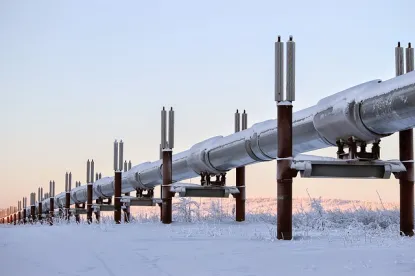PHMSA Seeks Comments on Proposal to Increase Information Submitted to NPMS
On April 11, the Pipeline and Hazardous Materials Safety Administration (PHMSA) published a notice and request for comments on an information collection to be submitted to the Office of Management and Budget (OMB) that would increase the geospatial data that operators of gas transmission pipelines, hazardous liquid pipelines, and liquefied natural gas (LNG) facilities submit to the National Pipeline Mapping System (NPMS). PHMSA also released an updated draft 2019 NPMS Operator Standards Manual. Comments on the information collection are due May 13.
Background: The Pipeline Safety Act directs operators of pipeline facilities (except distribution and gathering pipelines) to submit geospatial data and technical data, such as design and material specifications, to PHMSA for use in the NPMS. PHMSA has collected data for the NPMS since 1998. The revised information collection described in PHMSA’s notice was first proposed in 2014 and modified in 2016. The notice responds to comments received at that time.
Withdrawn Data Elements: PHMSA is withdrawing the proposal to require submission of the following data elements: the maximum allowable operating pressure (MAOP) or maximum operating pressure (MOP); percentage of SMYS (specified minimum yield strength); whether a hazardous liquid pipeline segment could affect a drinking water Unusually Sensitive Area; pump and compressor station locations; mainline block valve locations; and gas storage fields. If collected, these elements would be designated as Sensitive Security Information (SSI). PHMSA removed them from the proposal pending further research into safeguards and procedures for collecting this information.
Proposed Additional LNG Data Elements: With respect to LNG facilities, PHMSA proposes to require the submission of the following new attributes: type of plant, year constructed, capacity, impoundments and exclusion zones. This information would be viewable only by government officials via the Pipeline Information Management and Mapping Application (PIMMA). Information viewable by the public would include plant location.
Proposed Additional Pipeline Data Elements: PHMSA proposes to require the submission of the following data elements on a phased-in basis. Data elements that would be viewable by the public are noted with an *. All other data elements would be viewable only by government officials via PIMMA.
Phase I – to be collected the first submission year after the effective date.
|
Pipe diameter |
Class Location |
|
Commodity detail |
Gas HCA segment |
|
*Pipe Material |
*Abandoned Pipelines |
|
*Pipe join method |
*Onshore/Offshore |
|
In-line inspection (y/m) |
Coated (y/n) |
|
*Breakout Tanks (only locations and attributes, but not capacity, will be publically viewable) |
*LNG Plant location and attributes not restricted to government officials |
Phase II - to be collected the second submission year after the effective date.
|
Pipe Grade |
Facility Response Plan Sequence No. |
|
Seam Type |
Whether segment could affect HCA |
|
Wall Thickness |
Most recent assessment method |
|
Decade of Installation |
Most recent assessment year |
Phase III: In 2024, the following positional accuracy requirements become effective:
|
Hazardous liquid pipeline operators: |
Required positional accuracy of +/- 50 feet |
|
Gas transmission pipeline operators: |
Required positional accuracy of +/- 50 feet accuracy for all segments in Class 2, Class 3, or Class 4 areas; within an HCA; or have one or more buildings intended for human occupancy or an identified site within the PIR. |
|
All other gas transmission pipeline segments: |
Required positional accuracy of +/- 100 feet. |
Senators Edward Markey and Elizabeth Warren introduce pipeline safety legislation. On April 9, Senators Edward Markey (D-MA) and Elizabeth Warren (D-MA) introduced S.1097 proposing a number of changes to the Pipeline Safety Act. The proposed legislation would, among other things (1) mandate certain revisions to regulations relating to distribution integrity management programs (DIMP) and emergency response plans; (2) address PHMSA’s evaluation of state pipeline safety programs; (3) mandate pipeline safety management systems; (4) impose recordkeeping requirements for distribution operators; (5) require that professional engineers approve of certain pipeline safety tasks; (6) require upgrades to district regulator stations; and(7) increase the federal civil penalty limit from $200,000 to $20 million per day and from $2 million to $200 million for a related series of violations. Update on Reauthorization of the Pipeline Safety Act
On April 2, the House Committee on Transportation and Infrastructure’s Subcommittee on Railroads, Pipelines, and Hazardous Materials convened a hearing on pipeline safety issues, with a focus on the status of rulemaking directives contained in the 2011 and 2016 reauthorizations of the Pipeline Safety Act. Witnesses included PHMSA Administrator, Howard “Skip” Elliott, National Transportation Safety Board (NTSB) member Jennifer Homendy, and representatives of several pipeline trade associations and pipeline safety advocacy groups. More information, including prepared statements and a video link to the hearing, is here.
On April 10, the Senate Commerce, Science, and Transportation Committee’s Subcommittee on Transportation and Safety convened a hearing on pipeline safety. Witnesses included PHMSA Administrator, Howard “Skip” Elliott, NTSBA Chairman, Robert Sumwalt, and representatives of gas and hazardous liquid pipeline industry. More information is here.
PHMSA Rulemakings Update. The chart below shows the status of PHMSA’ pending pipeline safety rulemaking initiatives as reflected in DOT’s March Significant Rulemaking Report, PHMSA’s status Chart of legislatively mandated actions, and OMB’s Office of Information and Regulatory Affairs (OIRA) Fall 2018 Unified Agenda of Regulatory and Deregulatory Actions. The Unified Agenda appears in two principal parts, Current Agenda Agency Regulatory Entries for Active Actions and Current Long Term Actions.
New information appears in bold.
Pending Final Rules
|
Proceeding |
DOT Estimated Publication |
OIRA Estimated Publication |
PHMSA’s Chart |
|
Emergency Order Procedures |
April 22, 2019 |
October 2018 |
April 22, 2019 |
|
Safety of Gas Transmission Pipelines, MAOP Reconfirmation, Expansion of Assessment Requirements and Other Related Amendments |
August 20, 2019 |
March 2019 |
July 2, 2019 |
|
Safety of Gas Transmission Pipelines, Repair Criteria, Integrity Management Improvements, Cathodic Protection, Management of Change, and Other Related Amendments |
December 20, 2019 |
December 2019 |
Not Listed |
|
Safety of Gas Gathering Pipelines |
December 20, 2019 |
December 2019 |
Not Listed |
|
Safety of Onshore Hazardous Liquid Pipelines |
June 28, 2019 |
December 2018 |
June 18, 2019 |
|
Underground Natural Gas Storage Facilities |
July 2, 2019 |
December 2018 |
July 2, 2019 |
Pending Notices of Proposed Rulemakings
|
Proceeding |
DOT Estimated Publication |
OIRA Estimated Publication |
PHMSA’s Chart |
|
Class Location Requirements |
November 15, 2019 |
September 2019 |
Not Listed |
|
Gas Pipeline Regulatory Reform |
August 14, 2019 |
May 2019 |
Not Listed |
|
Liquid Pipeline Regulatory Reform |
Not Listed |
Feb. 2019 |
Not Listed |
|
Periodic Standards Update |
Not Listed |
April 2020 |
Not Listed |
|
Repair Criteria for Hazardous Liquid Pipelines |
Not Specified |
Next Action Undetermined |
Not Listed |
|
Valve Installation and Minimum Rupture Detection Standards |
August 7, 2019 |
January 2019 |
August 7, 2019 |
Pending Advance Notices of Proposed Rulemakings
|
Proceeding |
DOT Estimated Publication |
OIRA Estimated Publication |
PHMSA’s Chart |
|
Coastal Ecological Unusually Sensitive Areas |
Not Listed |
April 2020 |
Not Specified |
Other PHMSA Updates
PHMSA issues advisory bulletin identifying actions operators should take to address potential flooding damage. On April 11, in the wake of widespread flooding in the Midwest, PHMSA issued an advisory bulletin alerting operators of the potential damage that severe flooding, river scour, or river channel migration can cause to pipeline facilities. The advisory bulletin encourages operators to take a number of actions to prevent and mitigate damage and the effects of potential flooding, including: (1) utilizing experts in river flow to evaluate the potential for scour or channel migration at each pipeline river crossing; (2) determining the installation method of pipelines at river crossings to evaluate whether they can withstand flooding risks, and considering the installation of future pipelines using horizontal directional drilling; (3) determining the maximum flow at rivers where pipeline integrity is at risk and implementing contingency plans to shut down and isolate those pipelines when flooding conditions occur; (4) ensuring that controllers are aware of pipeline segments experiencing flooding; (5) coordinating with emergency and spill responders and other pipeline operators; (6) performing frequent pipeline patrols; (7) communicating with local and state officials; and (8) assessing pipe conditions when floods subside.
Executive Order directs PHMSA to revise LNG safety regulations. On April 11, President Trump signed an Executive Order (EO) on Promoting Energy Infrastructure and Economic Growth that among other things requires PHMSA to issue new regulations updating the Part 193 LNG safety standards to reflect best practices and best-available technologies. The EO states that, to the maximum extent possible, the new regulations must reflect risk-based standards. PHMSA’s existing regulations setting forth the design, construction, operation and maintenance requirements of LNG facilities were issued nearly 40 years ago. The EO also requires PHMSA to issue regulations allowing the transportation of LNG by rail car within 13 months.
PHMSA announces application deadlines for several pipeline safety grants.
-
One-Call Grant: This grant helps fund state agencies’ damage prevention efforts, including training, revising state underground damage prevention laws, compliance activities, and public education. The maximum award is $60,000. The total amount available is $1,058,000. Applications are due May 1.
-
State Damage Prevention (SDP) Grant: The purpose of the SDP grant is to provide funding to assist states in establishing and improving state programs to protect underground pipeline facilities from excavation damage. The maximum award is $100,000. The total amount available is $1,500,000. Applications are due May 1.
-
Technical Assistant Grant (TAG): TAG grants provide funding to local governments, tribes, and nonprofit organizations for technical assistance related to pipeline safety issues. The maximum award is $100,000. The total amount available is $1,500,000. Applications are due May 3.
-
Pipeline Safety Research Competitive Academic Agreement Program (CAAP) Grant: The CAAP grant provides funds to non-profit institutions of higher education for research innovation solutions to pipeline corrosion and other known pipeline integrity challenges. The maximum award is $200,000. The total amount available is $2,000,000. Applications are due May 3.
Updates from Industry
AGA releases white paper providing guidance on workforce knowledge, skills and communications. On April 8, the American Gas Association (AGA) released a white paper, “Skills and Experience for Effectively Designing Natural Gas Systems,” that provides guidance to operators regarding how to develop, maintain, and enhance key technical competencies required to safely and effectively perform engineering work functions for natural gas systems. The paper addresses tiers of foundational knowledge, design approvals, ethical responsibility, management of change, and continuous improvement.
API and AOPL release annual report on pipeline safety performance. The American Petroleum Institute (API) and Association of Oil Pipe Lines (AOPL) released their annual liquids report, “Pipeline Safety Excellence Performance.” The report provides data regarding incident rates for liquid pipelines and states that incidents affecting people or the environment decreased 20% over the last 5 years while pipeline mileage increased 12% during that time. The report also describes the industry’s four key goals of promoting organizational excellence, improving safety through technology and innovation, enhancing emergency response preparedness, and increasing stakeholder awareness and involvement.






 />i
/>i

